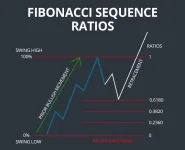- Joined
- Dec 16, 2024
- Messages
- 302
- Points
- 28

How to Trade Fibonacci Retracement - Fibonacci retracement is a powerful technical analysis tool that helps traders identify potential levels of support and resistance in the forex market. Here's a step-by-step guide on how to use it effectively:
1. Understand Fibonacci Retracement
Fibonacci retracement levels are derived from the Fibonacci sequence and represent key ratios: 23.6%, 38.2%, 50%, 61.8%, and 78.6%. These levels help traders identify where price might reverse or stall during a trend correction.2. Identify the Trend
- Uptrend: Look for significant swing lows and highs. The retracement levels will be used to find potential support levels.
- Downtrend: Look for significant swing highs and lows. The retracement levels will be used to find potential resistance levels.
3. Plot the Fibonacci Retracement Tool
- In your trading platform (e.g., MetaTrader 4/5, TradingView), select the Fibonacci retracement tool.
- For an uptrend: Drag from the swing low to the swing high.
- For a downtrend: Drag from the swing high to the swing low.
4. Watch for Key Levels
The price often retraces to one of the Fibonacci levels before continuing in the direction of the trend. The most common retracement levels are:- 38.2%: Indicates a shallow retracement.
- 50%: A psychological midpoint.
- 61.8%: Known as the "golden ratio" and a key reversal level.
- 78.6%: A deeper retracement level.
5. Combine Fibonacci with Other Tools
For better accuracy, use Fibonacci retracement with other tools, such as:- Trendlines: Align retracement levels with trendlines for confirmation.
- Support and Resistance: Look for overlapping levels.
- Candlestick Patterns: Watch for reversal patterns like pin bars or engulfing candles at Fibonacci levels.
- Indicators: Use RSI, MACD, or moving averages to confirm potential entry or exit points.
6. Plan Your Trade
- Entry Point: Enter when the price shows a reversal sign at a Fibonacci retracement level.
- Stop Loss: Place your stop loss slightly beyond the next Fibonacci level to minimize risk.
- Example: If trading at 61.8%, set your stop loss below 78.6%.
- Take Profit: Target the next significant Fibonacci extension level (e.g., 127.2% or 161.8%) or a previous swing high/low.
7. Risk Management
- Never risk more than 1-2% of your account on a single trade.
- Use appropriate position sizing to control your risk.
- Adjust your stop-loss and take-profit levels based on market conditions.
Example: Trading Fibonacci in an Uptrend
- Identify an uptrend and draw the Fibonacci retracement from the swing low ($1.2000) to the swing high ($1.2500).
- Watch for retracement levels at 23.6% ($1.2390), 38.2% ($1.2310), 50% ($1.2250), and 61.8% ($1.2190).
- If the price retraces to 61.8% ($1.2190) and shows a bullish reversal pattern, enter a long trade.
- Set a stop-loss at 78.6% ($1.2150).
- Set your take-profit at the previous high ($1.2500) or at an extension level like 161.8% ($1.2690).
Tips for Success
- Trade with the Trend: Avoid counter-trend trades unless you're highly confident.
- Be Patient: Wait for clear confirmation before entering trades.
- Backtest Your Strategy: Practice on historical data to refine your approach.
- Combine with Fundamentals: Keep an eye on news and economic events.

